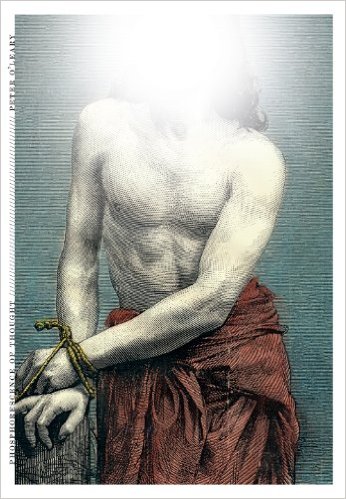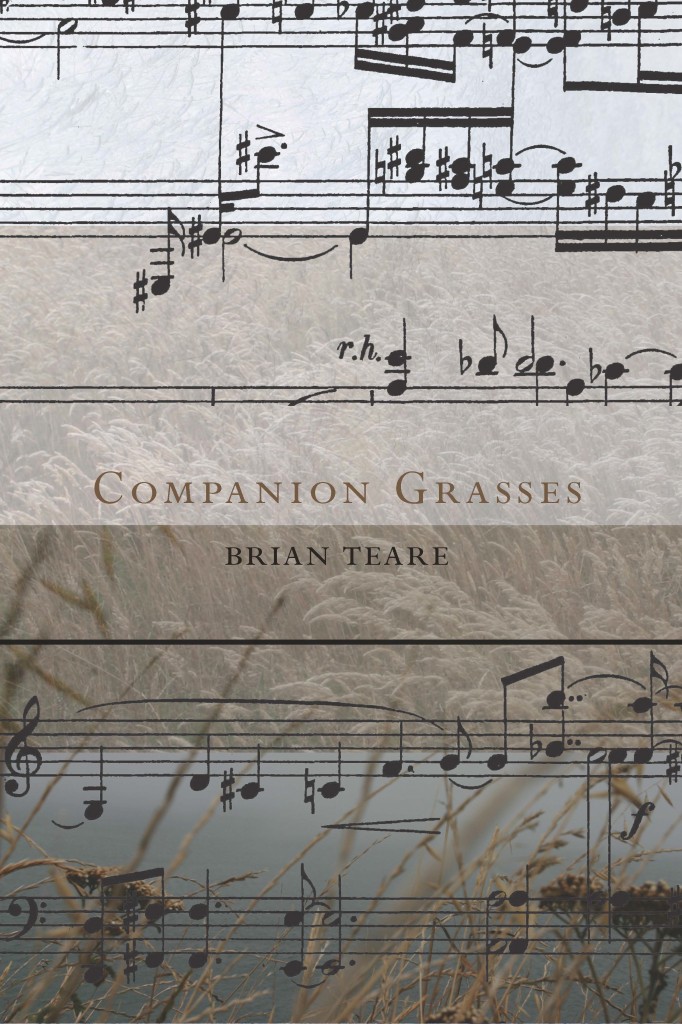Brandon Krieg: The Preserve of Poetry
The Phosphorescence of Thought
Peter O’Leary
The Cultural Society, 2013
Companion Grasses
Brian Teare
Omnidawn, 2013
In a 2012 group interview “Imagining Ecopoetics,” Brenda Hillman draws an apt metaphor between endangered species and endangered forms of thought:
One of the things ecopoetics tries to do is reconfigure the poem so as to include some of the endangered thought species. Poets keep track of radical and intimate encounters with the nonhuman. These encounters … include the permission to record the unacceptable or dysfunctional perception, the excess of feeling, or the integration of mythic states with other states.
Two remarkable recent collections of poems, The Phosphorescence of Thought by Peter O’Leary and Companion Grasses by Brian Teare are preserves of Romanticism, transcendentalism, and other endangered thought-forms, filled with radical encounters with the nonhuman. It should come as no surprise that, like Hillman, both authors revere Robert Duncan, who has lately become the hero of young American poets who know they must wrestle with the limitations of language and the depravity of late capitalism but nevertheless long for a poetry that is prophetic, visionary, and earnest. In his 2010 essay “Apocalypticism: A Way Forward,” O’Leary laments the loss in contemporary poetry of the visionary element present in mid-century avant garde poetry like Duncan’s, and calls for its return. Teare quotes or names Duncan a number of times in the long poem, “Atlas Peak,” which forms the bulk of the third section of Companion Grasses.
The Phosphorescence of Thought brims with radical encounters with natural others, starting with birds in a forest preserve near Chicago, praising them with the exuberance of Hopkins praising his kingfishers and windhover. Like Hopkins, O’Leary, who holds a PhD in divinity studies, grounds his fascination with nature in the Christian mystical tradition, especially in the scientific spiritualism of Pierre Teilhard de Chardin. Chardin, whom O’Leary glosses in the poem’s afterward, postulates a growing blaze of planetary thinking, an “incandescence, the culmination of psychical temperature that has been rising in the cellular world for more than 500 million years.” As O’Leary explains it, “Teilhard believed that the ‘Personal’ and the ‘Universal,’ that is to say the creaturely and the divine, are growing in the same direction to ‘culminate simultaneously in each other’ in a moment of complete illumination.’”
“Complete illumination” is lofty goal for a mystic, much less a poet, yet there are moments in The Phosphorescence of Thought that approach as close to it as any recent poetry has. Consider O’Leary’s evocation of the kestrel:
Kestrel:
its evidence is the air’s, that autochthonomous unearthing,
unleashing aerobatics to hover lustrously in a wind-groomed leewave.
That’s air’s predatory excesses trimmedinto an evolutionary
leanness.What’s it like to be a falcon?
As strange as being a man, and
as idiomatic—.It’s more owl than hawk.
More wisdom than war.
More hovering wind than merciful mind.
More mind than mentation.
More massively reentrant than speciously reentrancing.
More richly environmental than metaphorically unitary.
More autochthonomously unleashing than
through the void plummeting.
More splendidly envisioning than accident of life.
More gift than gall, more
phenomenal still. More like sleep rupturing waking than
like building a temple.
To coax the divine
in.
O’Leary glosses the coinage “autochthonomous” as “…of the earth’s own native law. Essentially, this is an adjective for evolution but evolution as if it were a theology.” One of the most refreshing aspects of The Phosphorescence of Thought is the way it convinces that the spiritual permeates an often brutal, indifferent physical world. In the passage above, the speaker praises the kestrel’s predatory wisdom, its stunning fulfillments of its biological imperative. Later, the poem marvels at the bird’s incredible eye, its instrument of predation, remarking the wonder of its one million cones, its two fovea: “Where in humans vision is a sense, / in falcons vision is thought itself, the avian mind’s ductile conversion / of reality into raptorial / being.” O’Leary fulfills Wordsworth’s prophesy in the preface to Lyrical Ballads that when science comes to make a material revolution in our condition (as it has in the two centuries since), the poet “will be ready to follow the steps of the Man of science . . . carrying sensation into the midst of the objects of the science itself.”
In alliteration and assonance, The Phosphorescence of Thought often sounds like Hopkins; in its long lines, anaphora, and expansive catalogs, it resembles Whitman; in its coinages and mythmaking, Blake’s genius shines through. Yet for all its earlier influences, it is a poem for our time—its rivers are thick with pollutants, its warblers are equipped with radio transmitters, and its “words of chemiluminescence” know that they are words, signs, yet nevertheless convey a longing to magnify the cosmos, to return it to its actual size.
Companion Grasses, too, includes an extensive bibliography of the influences present in each of its poems. The inclusion of such an apparatus might seem mere pretension in another kind of book, but in Companion Grasses texts are lenses that alternately bring the natural world closer or deepen its mysteries. The bibliography invites us to take up each of these lenses ourselves—a gesture like passing the binoculars. A wide assortment of source-lenses is offered—Basho; Emerson and Thoreau; Charles Ives; Martin Heidegger and Luce Irigaray; Susan Howe and Brenda Hillman, to name only a few.
In Companion Grasses, these sources have been lived with, loved and wrestled with, and their conjuring by Teare’s speakers reminds us that thought is always a collective endeavor mediated by the languages we share. Teare’s sources throw into relief intense perceptions of natural phenomena, the exaltations and difficulties of sex and love, and a host of important memories. In Companion Grasses we walk with a sensitive, intelligent guide through a series of personally transformative landscapes. The forms the guide uses to evoke and elucidate the sights are too various to do justice to in such a short review—suffice it to say there is something of Thoreau’s Journal’s acute particularity of observation presented in prose blocks, of Lorine Niedecker’s tight, striking rhymes and sentences cascading across stanzas, and of Duncan’s single-word field experiments.
Yet, Companion Grasses declares its own formal and experiential territory, especially in its novel second part, the long poem, “Transcendental Grammar Crown,” in which each section’s title picks up a suggestive fragment of the last line of the previous section to create a fraught continuity (between source and self, language and experience) always on the brink of rupture. Indeed, the occasion of many of the poems in the collection is a desire to at once praise and transcend the sources that color its speakers’ seeing. In a particularly moving section of “Atlas Peak,” observation, memory, and text are interwoven to both acknowledge the speaker’s debts to other sources, and to insist on the validity of his own experience:
often I climb up
and find myself thinkingof my father dead now a year,
how near I was to him
in my ambivalence; he wasthe thing I held away
& so held it closer
for how intently I examined it
thinking myself safe
from influence. I loved him
before I knew anything
about him—the way I lovedHeidegger, Ives, Duncan
& the idea of California,
all four essentially crazy
with ambition, injured,
unethical, genius, sweetly
suckered by beauty
& the thought of beauty.So much of our seeing
lies in forgetting the laws
of the fathers, the ones
we were given, & the ones
we choose, as though we look
always at landscape first
through their eyes, a valancingscrim of quotation, before
we blink & see—what?
What we love, how we care for it,
is where we live: bay trees
so potent today after last night’s rain
our shirts smell still
of leaves we barely brushed by; walkingwith my thumb in a book
to mark a thought; returning…
The final image of this excerpt shows that it is not by pretending not to be influenced that we achieve something new, but by—even as we are marking our place in the book—allowing the world in, in the form of bay leaves in this instance, to shock us with its presence. We forget the “laws of the fathers” (and of the mothers elsewhere in the collection) by working through them, mourning them, to find out what we love and how to care for it.
—
Brandon Krieg is an Associate Editor for Poetry Northwest


